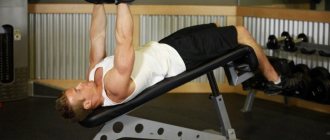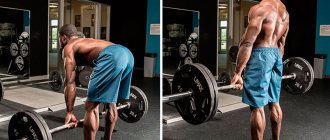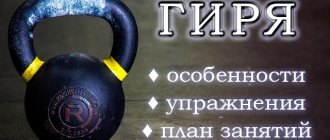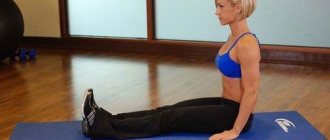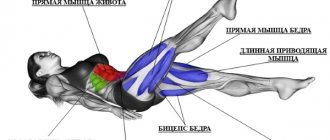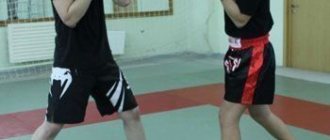Using a kettlebell, you can replace the usual military barbell press technique. In addition, holding and squeezing a kettlebell requires the work of more muscles. Previously, the kettlebell press was part of the mandatory kettlebell lifting triathlon complex. Now this exercise is used separately not only in CrossFit, but also in gyms as an assistant for the development of deltas.
What muscles work when pressing a kettlebell?
First of all, when pressing a kettlebell, the deltoid muscles are activated, especially the anterior bundles. Accessory muscles include: triceps, upper trapezius, rhomboids. In addition to the core muscles, the back and abdominal muscles work during the press, which stabilize the position when lifting the projectile, which does not happen to the same extent with the military barbell press. Like many kettlebell exercises, the bench press develops deep muscles that are not worked by isolation exercises for the deltoids.
Exercises with weights for weight loss and muscle growth
A set of exercises with weights is suitable for both weight loss and muscle gain. But the main goal of training with kettlebells is to develop strength endurance. Complexes with kettlebells are a great help in training wrestlers, because... develop both agility and endurance.
If you do exercises with weights to lose weight, then the main thing is to maintain a diet (calorie deficit) and you will lose weight. For beginners, the most important thing is regularity and proper nutrition (with which at first not everything is clear and there are many mistakes).
But if you specifically want to increase muscle mass, then a kettlebell (even 16 kg and 24 kg) is not the shortest way. If you are no longer new to the gym, then training with kettlebells will help improve endurance and agility, and strengthen your joints. But beginners, as a rule, want maximum muscle as quickly as possible (so that there is motivation not to quit training). Therefore, for this purpose, it is better for them to start with classic training with barbells and dumbbells. Although, if you wish, you can do some exercises at home with a weight. Just replace the dumbbell with a kettlebell where possible (squats, deadlifts, etc.).
However, if you want to start training and you only have a 16kg kettlebell in your equipment, then start doing exercises with kettlebells. They will give you much better results than exercises with only your own weight (pull-ups/push-ups, etc.) or exercises like “lying on the couch” or “sitting on a chair.”
Contraindications and precautions
- In case of hernias, protrusions of the spine, or disc displacements, loading with weights is contraindicated.
- If you experience pain in the joints, even when working with light weights, you should wait to do the bench press.
- Do not “break out” your hand; keep your forearm and hand in a straight line.
- Try to perform the press up concentrated, do not jerk. It is important not to confuse the exercise with kettlebell pushes, because they are not performed with the shoulders, but with an impulse due to the power of pushing out the legs.
Features of the exercise
- While doing the bench press, your body should be tense and you should be standing firmly on the floor/platform.
- The hand should not bend or straighten during execution; it forms a single line with the forearm, this way you will ensure your safety.
- Avoid jerking, work only with the strength of the muscles of the arms and deltas.
- Choose the weight of the kettlebell according to your own strength characteristics; it’s better to take a kettlebell of less weight, but perform more repetitions, than to take a heavy kettlebell and injure your joints.
Where to begin?
- Warm up the muscles and joints not only of the shoulder girdle, but of the whole body. Since the kettlebell press is not isolated work of the arms, the muscles of the back and abdomen are involved here, so it is important to avoid injuries by fully warming up.
- Naturally, to begin with, choose a small load weight - from 8 kg. If this weight turns out to be heavy, perform the load with dumbbells or kettlebells of lower weight.
- Having mastered the technique with one hand, proceed to press two kettlebells while standing, also choosing the load correctly.
- Learn the technique of lifting the kettlebell to the starting position. The jerk, or lifting the weight to its original position, happens like this: while bending over with a straight back, grab the handle of the weight, swing back and forth, allowing the weight to fly up. In the middle of the amplitude, bend your elbow and carefully rotate your hand so that the weight rests on your forearm.
- Under no circumstances should you jerk through pain , always keep your back straight, avoid injury to the intervertebral discs and pinched nerve endings.
Video: Exercises with a kettlebell (16 kg or 24 kg)
The video shows basic exercises with a kettlebell. Marie, bench press, clean and jerk, squats are the basis of any training complex with weights. Below there is a detailed description and video for each exercise. And at the end there are three ready-made sets of exercises that can be done both at home and in the gym. The main thing is that there is enough free space. Move away the TV, crawling back-eaters and curious relatives.
1 Deadlift with kettlebell
Technique:
- feet slightly wider than shoulders, moving your pelvis back, lean forward with a straight back
- grab the handle of the weight with both hands
- Without lifting your heels from the floor, also with a straight back, straighten up (no need to lean back)
2 Kettlebell swings
Technique:
- feet slightly wider than shoulder-width apart, grasp the weight with both hands
- arch in the back
- do kettlebell swings overhead
- in the lower position, do not round your shoulders too much, bend your legs slightly at the knees, straight back (do not hunch), bring the weight back, behind the level of your feet
- in the upper position, fully straighten (including your elbows)
3 Squats with a kettlebell (“Goblet”, “goblet”)
Technique:
- Take the weight so that the handle rests on your chest (see video below)
- perform squats: legs slightly wider than shoulders, toes turned slightly outward, when moving down, spread your knees to the sides
- squat just below parallel with the floor, do not lift your heels off the floor
- don’t hunch your back, don’t lean forward too much
Kettlebell squats technique (video)
4 Rise in Turkish
This kettlebell exercise will be challenging for beginners, but it is still very effective. Not only do all muscles work, from the biceps and shoulders to the calves, but coordination is also involved (more than in other exercises with a kettlebell). To avoid dropping the weight on your face and falling, first learn to do the exercise without a weight or with some small weight/dumbbell (2kg, for example).
Turkish rise with a kettlebell technique (video)
5 Standing kettlebell press with one hand
Technique:
- jerk the weight onto your shoulder, then straighten your arm and lift the weight up
- then lower the weight back onto your shoulder
- keep your body straight, do not lean back or forward
Standing kettlebell press with one arm technique (video)
6 Kettlebell snatch and jerk
Technique:
- the weight stands approximately 20 cm in front of the socks
- bend over with a straight back, take the kettlebell with a lock grip, pull it between your legs by the heels
- “accelerate” the weight until it explodes (to waist level)
- do a kettlebell lift - stand up completely straight with the kettlebell
- with a sharp movement, pull the hand with the weight towards you, moving your shoulder back
- picking up the weight and fixing it at the top with a straight arm
- dropping the weight (try to reduce the amplitude of the fall of the weight as much as possible)
- return to starting position
Video: Kettlebell snatch and jerk technique + auxiliary exercises
One-arm kettlebell press technique
- Take the starting position, with your feet slightly wider than your pelvis, grasp the handle of the weight with one hand while bending over, and jerk the weight toward your chest, as indicated above for the precautions.
- Place your elbow close to your body, the kettlebell resting on the side of your forearm, and your hand near the shoulder joint. Keep your other hand loosely to the side.
- Tighten your back and abdominal muscles, keeping your spine straight.
- Exhale as you press up, lifting the weight vertically above your shoulder joint. Turn the hand with the weight away from you.
- Slowly lower the weight down along the same trajectory, do not throw the weight of the load; the movement is accompanied by inhalation.
- Perform the required number of presses, take the weight in your other hand and repeat the same number of times.
After performing the movement, straighten your elbow as if you were dropping a weight. But the release should not be accompanied by a jerk in the joints. Smoothly lower the weight with a straight back.
The best abdominal exercises with kettlebells
Standing interceptions
You need to stand up straight and take the weight in one hand. Bring it behind your head and grab it with your other hand, and then without stopping, bring it forward and grab it again. Continue in this mode for about half a minute, and then start doing interceptions in the other direction for the same amount of time. Together with the abs, this exercise works the arms, back and entire shoulder girdle.
Lower interceptions
You need to stand up straight, with your feet wider than shoulder-width apart. Bring the weight in one hand back between your legs and grab it with your other hand. Perform similar interceptions in one direction and then in the opposite direction for 30 seconds. At the moment of interceptions, tilt your torso slightly, straining your abs and thereby unloading your spine.
Knee Raises
Squeeze the weight up with your hand, and then lower it down to the side of your body, simultaneously raising the knee of your leg on the same side and trying to reach your elbow with it. The higher you raise the limb, the more the press engages. At this moment you should feel the tension in your oblique abdominal muscles. Do 10-12 reps on each side.
U-turns with a kettlebell
Standing straight on the floor, grab a kettlebell with both hands and lift it to chest level. Hold it upside down and begin to rotate your torso to the sides, keeping your hips still. This exercise works the oblique abdominal muscles well.
Double kettlebell press technique
- Place two weights together, stand in front of them with your feet slightly wider than your pelvis in a stable position.
- Bend over and grab the arms, throw two weights to the starting position - weights at the shoulder, elbows pressed as close as possible to the body.
- As you exhale, press both weights up above your shoulders without leaning your body back .
- As you inhale, lower the weights to the starting point.
- Complete the set and gently release the weights without jerking and lower them to the floor.
Important! Perform the technique on straight legs, do not squat when pushing out the weights. Remember that the exercise is done in a concentrated manner, try to isolate your shoulders from the help of your pelvis and legs.
Rules for performing the exercise
Initial position:
Before starting the exercise, the kettlebell is placed in front of you. Place the weight over your chest. The elbow is pressed to the body. Make sure your legs are straight at the knee joints. There is no dip here, as in the kettlebell push, the entire load goes to the deltoid muscles. The gaze is directed forward.
Position 1:
Next, straighten your working arm vertically upward without jerking. Hold this position for a second.
End position:
Place your hand on your shoulder. Make sure that the hand and forearm form a single line. The natural deflection is maintained in the lumbar region.
Repeat the exercise as many times as necessary. Variations of the military press with kettlebells can be the military press with a barbell or with kettlebells while standing and sitting. You can see the detailed technique for performing the exercise in the following video with Ksenia Dedyukhina, the world champion in the kettlebell push.
Alternative replacements for the two-arm kettlebell military press
The kettlebell press is a basic exercise in which the deltoid muscles, as well as the arm muscles, receive the main load. The following are exercises that can replace the military press or alternate it on different training days.
Press kettlebells overhead from a squat. The deltoid muscles are maximally used here, as well as the quadriceps and gluteal muscles. The exercise is universal because it is aimed at developing a large number of muscle groups.
Kettlebell overhead press from a squat
Kettlebell push with one hand. This exercise is basic in kettlebell lifting and is similar to the military press, differing in the inclusion of leg muscles in the work. When pushing the weights with your legs, we do a squat, thereby helping to push the weights to the top position.
Kettlebell push with one hand
Army barbell standing press. This exercise uses the same muscles as the kettlebell military press, but is simpler because it uses a barbell. Having an unusual and uncomfortable shape, the kettlebell complicates the exercise.
Standing barbell press (military)
Standing kettlebell press in training plan
The benefit of the kettlebell press is that it requires concentration and stabilization. It teaches the correct upward pressing movement, and is a lead-in movement to the popular CrossFit pushes, barbell thrusts, and standing presses. It allows you not only to gain upper body muscle mass quickly, but also to develop the neuromuscular connection required for strength training. For women, this exercise will help avoid imbalances in the upper and lower body, and work the center of the body under load, preparing the body for heavy basic movements with a barbell.
The standing kettlebell press should be the first exercise in a beginner athlete's training plan to achieve full concentration on muscle contraction and quickly develop technique.


